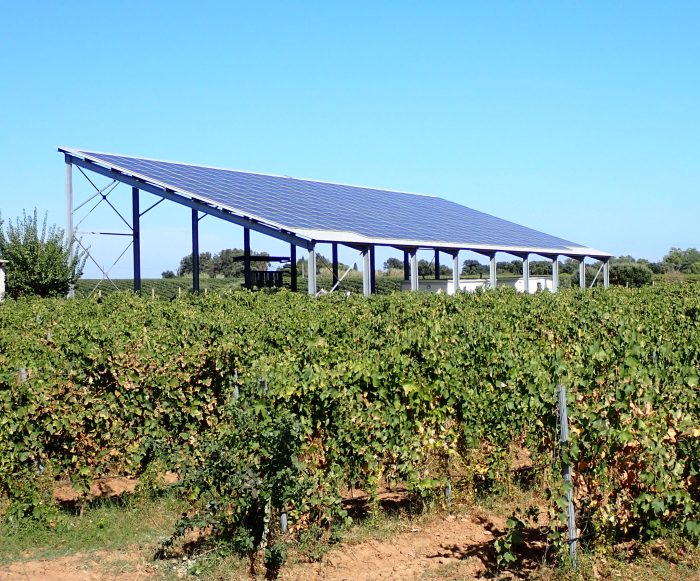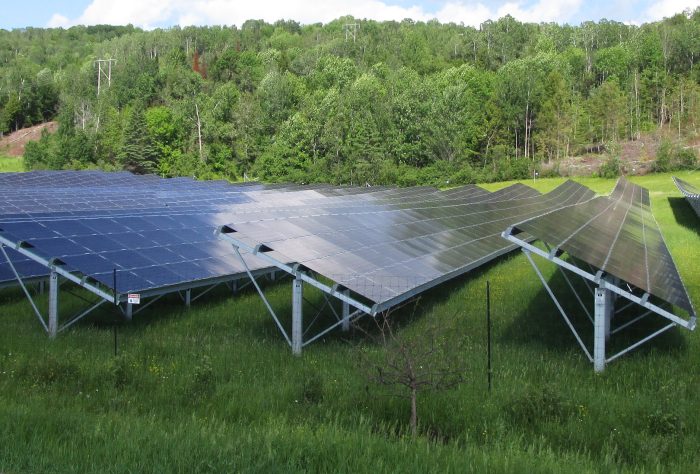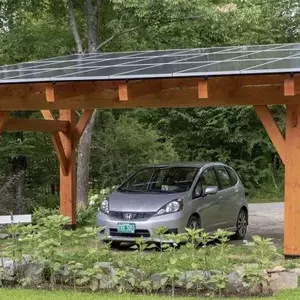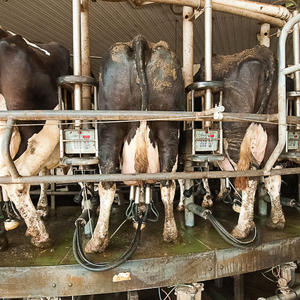
A few years after I moved to Vermont in 1974, I was talking with a local dairy farmer in his dooryard, and I said that I admired his new barn. His Vermont answer was classic. “That’s not a barn,” he said. “That’s an equipment shed.”
Oops. Okay. Since then, I’ve remembered the lesson. Cows are sheltered in a barn, while tractors are sheltered in an equipment shed.
While many Vermont dairy farmers are financially struggling, we still have plenty of active farms in Vermont—most of which have at least one barn and at least one equipment shed.
Ground-mounted arrays with tractors underneath
During a recent visit to France, I noticed lots of farms with relatively new equipment sheds. These newer buildings all looked alike. They were steel-framed buildings with steel roofing covered with photovoltaic (PV) modules. Clearly, a local company was promoting this style of building to farmers.
These equipment sheds were a cross between a photovoltaic shade structure—something you might see in a California parking lot—and a farm building.

Vermont farmers install photovoltaic arrays, too—but in Vermont, the photovoltaic arrays are usually on ground-mounted arrays that make the land unfit for agriculture.

The advantage of the French approach is that the photovoltaic arrays didn’t gobble up any agricultural land. When I stopped at a French farm to talk to a farmer about his equipment shed, I asked him how many years it would take for the investment to pay off. “After about 20 years, it’s paid for,” he told me.
What are these buildings called?
Once home in the U.S., I did some Googling to try to figure out what these French equipment sheds are…
Weekly Newsletter
Get building science and energy efficiency advice, plus special offers, in your inbox.

This article is only available to GBA Prime Members
Sign up for a free trial and get instant access to this article as well as GBA’s complete library of premium articles and construction details.
Start Free TrialAlready a member? Log in















16 Comments
I pieced together what it would take to build a mini shed like this. Thinking more 14x20 or something along those lines. Post frame shed, sort of like a "loafing shed." And then use bifacial panels on the roof, no other roofing between. Seal between the panels for water in one way or another. Doesn't need to be perfect, it would be a gravel floor shed. The advantage would be the natural light coming through a bifacial panel. Lots of DIY'ers have done similar things. Not much in the commercial installer space though as you mention. I think a 14x20 post frame shed with gravel floor could be built for $2-3k in material. Depending how large your overhangs are on a 14x20 shed, you could fit about 6kw on the roof.
Probably no US distributors, but Estonian company SolarStone offers roughly what you describe - PV panels acting as roofing (sort of BIPV), 6 kW, etc for a lot less than SunCommon. Simple install with helical screws or the like. https://solarstone.com/products/solar-carport
Excellent. I was sold on the idea by Kiley's article on Solar carports that Martin linked to: https://www.greenbuildingadvisor.com/article/timber-framed-solar-canopies
This expands the concept to a scale where it makes even more sense. In urban areas roof top solar is usually the only viable option, but they often sit in an uncomfortable relationship to the roof shape and architecture, and represent a compromise in the number of panels that can be used. Where there is more room, ground mount still ends up using valuable land, with little other benefit. Open or semi-enclosed structures are a natural fit.
At 200 kW, an array of this size produces an awful lot of electricity. Many farms are big electric consumers, but certainly not all. They'd have to be grid-tied, of course, and my understanding is that many US utilities don't allow private arrays that generate more juice than the customer uses on site. Would appreciate comment on this matter.
Andy,
Of course you're right that U.S. utilities have policies that differ in many ways from the policies in other countries, including France.
That said, U.S. investors (whether farmers or not) are installing large PV installations in the U.S., and are often finding these investments to be lucrative. (In Vermont, for example, agricultural pastures are being converted into large solar installations at such a fast rate that it's hard for me to keep track of the new "solar farms." Every time I drive to Montpelier, I see new arrays.)
How lucrative these PV installations are for the investors depends on the details of the electricity purchasing contracts being offered by local utilities (as well, of course, as available incentives from government agencies), which vary widely from state to state.
What I'm seeing is a market with two sides: utility-scale and everything else. Here in Ohio we're also seeing massive solar installations; I've been involved in a citizens' group advocating for local permitting. I also know that rules and regs vary widely from state to state. But everywhere, I think, the big players have a whole different set of rules because they're quite literally building or augmenting the transmission infrastructure as well. What I'm curious about is the viability of projects like this--bigger than a typical residential 5 kW rooftop but still several orders of magnitude smaller than utility-scale. These hangars PV approach the size of municipal arrays around me, but those seem always linked to a water or sewer facility that consumes the entire output.
In another angle, I'm always troubled when large-scale rooftop PV is advanced as a better alternative to utility-scale ground mounts because it doesn't use farmland. Apples and oranges--rooftop has its advantages, but we simply don't have enough roof to do this at the scale needed for our energy appetite.
Ground scale has huge issues. In my state of MA, thousands of acres of forest are being clearcut to make room for utility scale panels. In my humble opinion, destroying an entire forest is more harmful to that (now deceased forest's) biodiversity than even extreme climate change.
Similarly, converting prime farmland in temperate regions (like Ohio and Vermont) to solar farms is the definition of insanity. Because you've got aquifers being drained across the west to support agriculture, while eastern temperate states have plenty of water.
Ground solar at least in a populated state like MA, paves the way for further development. A large scale solar farm involves clearing and leveling land, a new access road, and utility connections. It's now a prime target for further development in a few decades, or if subsidies are cut off by an unfriendly presidential administration.
Ground solar should only be done where it's serving dual purposes (like this article) or in deserts with low biodiversity. Any electricity that can't be generated from rooftops or deserts should be supplemented with nuclear.
Sam,
Don't be so quick to judge Vermont farmers. It's not as if 100 acres of Vermont pasture yields a decent living for a farm family anymore. Before dictating land use rules, you need to explain to me which crops Vermonters can profitably grow.
Martin, the site is not letting me reply to your comment directly, but hopefully you see this.
I don't judge Vermont (or Ohio) farmers on what they need to do to make a living off of their land. I do bemoan the policy and cultural decisions that have led us to this point.
The reality is that ag and energy are both heavily subsidized industries, and our government and tax dollars have a huge amount of influence. In the absence of government subsides, it would make no sense to clear-cut forests in MA to put in utility scale solar. It also makes non sense that local farms can't afford a living off of 100 acres, while a Suadi Arabian company drains Arizona's aquifers for agriculture.
Maybe I'm being young and naive, but it seems to me that subsidies would be better spent funding energy development in areas with lots of sun and little precipitation (Arizona) and agriculture in areas with lots of rain (New England). Absent that, I think there's nothing wrong with frowning on subsidized ground based solar when there are still plenty of rooftops and desert available.
Sam,
You're absolutely right that government subsidies affect agriculture as well as photovoltaic installations, and that most of these subsidy programs have unintended negative consequences. We certainly need to remove existing subsidies for fossil fuel production, as well as subsidies that benefit huge farms over small farms.
In the face of the current climate emergency, these decisions become much more complicated and hard to make. Perhaps you are right that most new solar installation should be installed in southwestern deserts -- but that policy decision would raise a great many questions. Many environmentalists are worried about injuries to desert species. Moreover, your plan would require long-distance transmission lines -- in other words, a huge increase in powerline construction projects -- and these projects are notoriously difficult, due to permitting problems and NIMBY protests. I'm not sure whether the planet can afford to wait for your plan to be implemented.
Electricity production is relatively local because there are large losses in transmission. Even with regional producers, 2/3 of the energy produced, on average, is lost to heat in transmission. Moving electrons from the SW desert to New England would require far larger solar arrays than installing them locally.
Michael,
While I agree with your argument -- that we need to produce our electricity close to the places where the electricity is used -- your numbers are wrong. Here's what's accurate, to the best of my knowledge:
* 1-2% of energy is lost during the step-up transformer from when the electricity is generated to when it is transmitted.
* 2-4% of energy is lost in the transmission lines.
* 1-2% of energy is lost during the step-down of the transform from the transmission line to distribution.
* 4-6% of energy is lost during the distribution
So, the average loss of power between the power plant and consumers ranges between 8-15%.
The above information comes from this website:
https://chintglobal.com/blog/how-much-power-loss-in-transmission-lines/
Larger numbers that some sources cite usually involve a misunderstanding and include energy losses (thermal losses) associated with burning coal to generate electricity. These losses associated with generation are different from losses associate with transmission.
Martin, that's fair enough. In my utopia, we'd get our power from a mix of desert solar and nuclear plants. The government wouldn't subsidize fossil fuels or Tesla, and instead would invest in new technologies like better batteries and space based solar arrays. But Utopian thinking rarely works out in the real world.
But to get back to the original comment from AndyCD "In another angle, I'm always troubled when large-scale rooftop PV is advanced as a better alternative to utility-scale ground mounts because it doesn't use farmland." All things being equal, ground solar is far worse. Policy in democracies is usually downstream from culture. I understand we need to solve climate change, but we shouldn't pretend all solutions are equal or desirable. As long as there are available rooftops on warehouses, factories and farm sheds, I think we should frown on ground based solar. If enough people do, we might get better results from policy.
I always regret ignoring the voice that says, "better check your numbers before posting..." I was thinking back to my Passive House training, and many presentations I've seen, that talk about "site energy" as about 1/3 of "source energy." You're probably right that it probably includes the efficiency of the power plant converting the raw materials into electricity.
Tax policy is a big part of this.
In the US, you get a 35% tax credit for a solar installation. The structure that supports your panels is included in that credit, but only if it is necessary to the functioning of the panels. If you build a shed to hold your panels, you can't get a credit for the cost of the shed. However, if you built a standalone frame, you get the credit for the cost of the frame.
Innovator Matt Wagner at Upright Energy (https://uprightenergymaine.com/solarsheds/) has been doing this for years with great results/testimonials. Costs are often competitive with a home roof installation, and you get a storage shed for free!
Log in or become a member to post a comment.
Sign up Log in